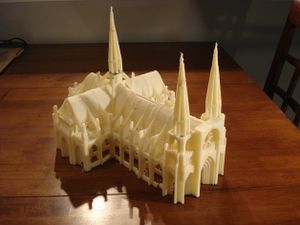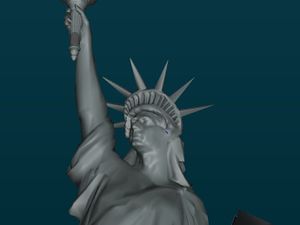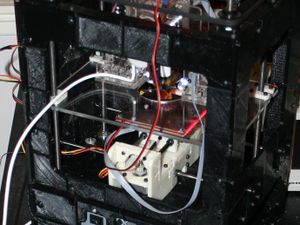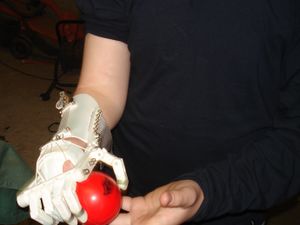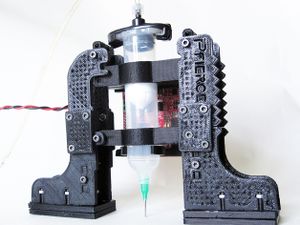User:Jarred
Hi, I am Jarred Glickstein
Blog 2: Open Source Ecology
When I watched Marcin's TED talk I got the feeling this project has high potential. The Open Source Ecology project is absolutely astounding. I would describe this effort as a positive and potentially world changing effort to put basic technologies in reach of anyone.
There are people around the globe live without houses. Those people have to spend days on end making bricks to build a house. If those people had access to the plans to make an open source brick press, their lives would be changed. Suddenly the basic human need of housing, formerly difficult to attain, is brought within the reach of many people who can now produce bricks faster and spend less time on such a basic need. It frees people. Such is the idea of the OSE project, which aims to free people and empower the world with the ability to build industrial machines and maintain cilvilized living for yourself. They publish fairly regular videos documenting their progress on Vimeo.
The latest update to their development blog was made last November and showcased an open source 100W lasercutter. This effort proves the potential of the project to have a wide scope and that the fifty tools they are developing have the potential to enable you to make anything.
The New Yorker's article was an interesting critique which offered insight into what really happens on the farm Marcin Jakubowski, the OSE project founder, purchased to be the foundation for his open source civilization. A lot of the article reveals appalling living conditions and a lack of work effort on the part of some of the inhabitants. It mentioned comments made by people who had been a part of the project at one point or another. Many cited a lack of skills, stating the project had a lot of interested individuals who were more interested in the idea of the project than they were actually able to help. I find this critique interesting as it reminds me of the idea of the invisible hand in economics. Economists use the idea of the invisible hand to explain why things fall into place - as in why, without someone dictating each thing to do, modern life fell into place piece by piece, owing its creation to millions of people with skills. The New Yorker article pointed out that the OSE project has an ambitious goal with specific steps to get there. I think that by dictating what will happen and what the goal is, it makes the project difficult to achieve comfortable. I have no doubt that the goal of designing fifty open source machines is achievable, but the idea of being totally self sufficient from the beginning is unthinkable, as the article indicates, because it forces people to live without heat, cooling, clean water, and even food while trying to put together these machines.
Marcin's response to the article clarified the purpose of the project. He redefines the scope of his project, which is specifically to create the fifty open source machines he identified as the basis for civilization. He specifically mentioned that it is not their goal to create a commune or other small community. This was a view that the New Yorker article pushed, but Marcin retorts it as innacurate. The poor living conditions mentioned in the New Yorker article, according to Marcin, are due to his pushing all of his funding into building machines. It is not a lack of resources so much as it is an intentional focus on just the project. Marcin is so focused on his project he is willing to give up conveniences of modern life.
When I think of Marcin's project, I see his goal as giving people access to information, and by extension access to machine tools. I do not think the administration would be willing to support such a thing, but I think the administration should. It would be the goal of our own OSE project to provide access to basic and complex machines to students. Considering this is a university, that seems like a good way to enhance our learning. Marcin stated in his TED talk that he graduated with a PhD and "realized [he] was worthless". Imagine if we had access to practical machine tools now. We could produce things for ourselves, and upon graduation have more confidence in our skills, more self-sufficiency, and a greater appreciation for the skills required to produce products. I cannot think of any specific professors or students who would be interested in this project. However, if I was going to look for allies in such a project, I would identify people with a common interest but different skill sets. I would want people with a variety of talents and abilities, a positive attitude, and the willingness to do work. From the way the OSE project is designed, funding should not be as much of a hurdle as one might think, as we would be building our own machines. Much like building open source 3D printers for $500 or so rather than buying $500,000 stereolithography machines, an open source machine project makes a variety of tools and machines more attainable.
Blog 1: Objects from Thingiverse
Something Amazing/Beautiful
This Gothic Cathedral Playset design was posted to Thingiverse just less than two months before I got my first 3D printer working. I remember how astounding it was that it was printable. At that time it was a huge stretch to be able to make this. 3D printing has come a long way since then but this model remains astounding.
Something funny or strange
Bre Pettis, cofounder of MakerBot Industries, had no idea what he was getting himself into when he uploaded a model of his head to Thingiverse. The Bre of Liberty is just one of many strange mashups made with various objects. If you direct your attention to a Thingiverse search for "Bre mashup", Bre has been mashed up with a dolphin, a bust of Beethoven, and more!
Something useless
This is a printable Cupcake CNC chassis. I do not like to judge other people's work, especially not to the degree of calling someone's work useless. However, my adventures in 3D printing have shown that there is a time and place for every machine. The MakerBot Cupcake CNC chassis was made on a laser for a reason. Printing it out of tiny interlocking squares seems a bit pointless. These large, flat panels are better suited to being made on a laser.
Something Useful
The Robohand project goes above and beyond the call of duty in terms of usefulness. This is an open source, freely available, and printable mechanical hand, designed to be used as a prosthetic. The aim of the project is to make prosthetic devices that are more comfortable than commercial alternatives and more available to people who are missing fingers for any reason.
Something which surprised me
The Pfiercestruder is an interesting piece of work. MakerBot Industries released a paste extruder months prior and began to sell kits in their online store. However, someone without a laser cutter made a printable version! This is surprising because it demonstrates the unexpected resourcefulness of 3D printer operators. Even more so, it surprised me because it was unexpected. MakerBot was putting out products to make a profit, and their community of users was figuring out ways to not buy these products and instead use their home MakerBot printers to print everything else MakerBot has designed.
